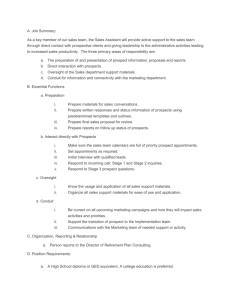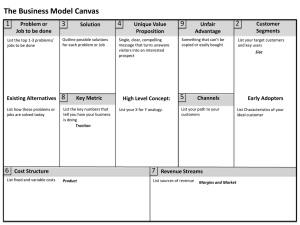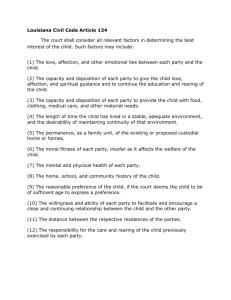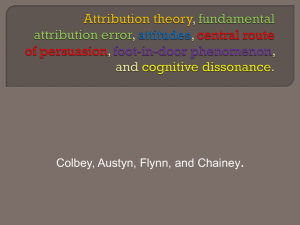“WHAT DRIVES THE DISPOSITION EFFECT? AN ANALYSIS OF A
advertisement
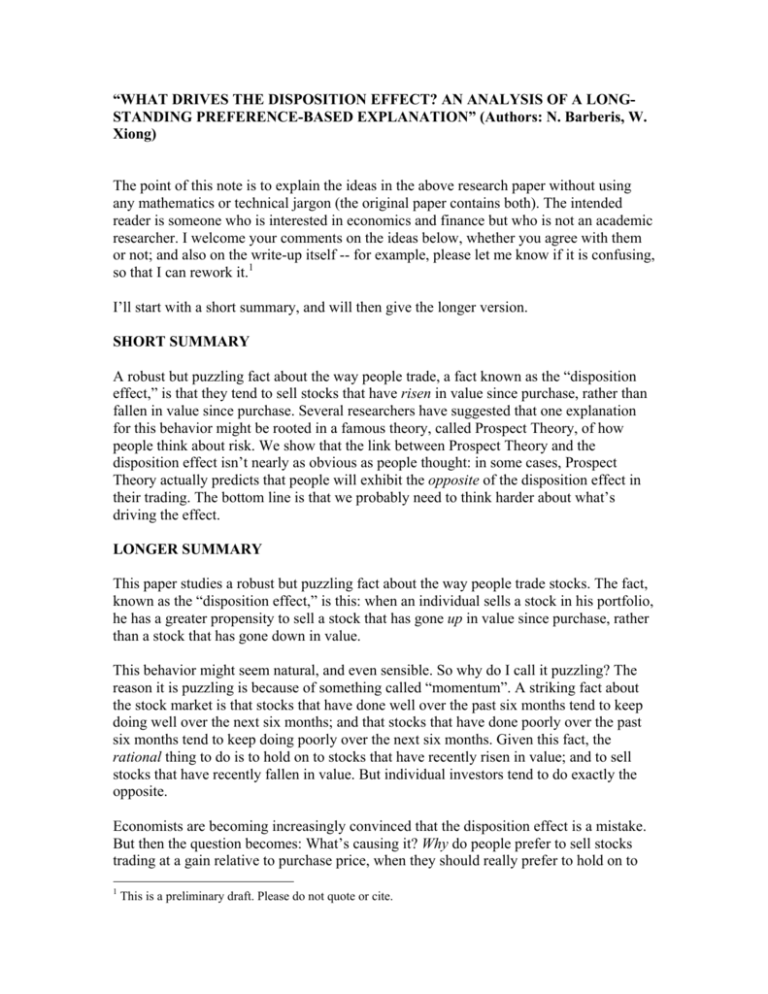
“WHAT DRIVES THE DISPOSITION EFFECT? AN ANALYSIS OF A LONGSTANDING PREFERENCE-BASED EXPLANATION” (Authors: N. Barberis, W. Xiong) The point of this note is to explain the ideas in the above research paper without using any mathematics or technical jargon (the original paper contains both). The intended reader is someone who is interested in economics and finance but who is not an academic researcher. I welcome your comments on the ideas below, whether you agree with them or not; and also on the write-up itself -- for example, please let me know if it is confusing, so that I can rework it.1 I’ll start with a short summary, and will then give the longer version. SHORT SUMMARY A robust but puzzling fact about the way people trade, a fact known as the “disposition effect,” is that they tend to sell stocks that have risen in value since purchase, rather than fallen in value since purchase. Several researchers have suggested that one explanation for this behavior might be rooted in a famous theory, called Prospect Theory, of how people think about risk. We show that the link between Prospect Theory and the disposition effect isn’t nearly as obvious as people thought: in some cases, Prospect Theory actually predicts that people will exhibit the opposite of the disposition effect in their trading. The bottom line is that we probably need to think harder about what’s driving the effect. LONGER SUMMARY This paper studies a robust but puzzling fact about the way people trade stocks. The fact, known as the “disposition effect,” is this: when an individual sells a stock in his portfolio, he has a greater propensity to sell a stock that has gone up in value since purchase, rather than a stock that has gone down in value. This behavior might seem natural, and even sensible. So why do I call it puzzling? The reason it is puzzling is because of something called “momentum”. A striking fact about the stock market is that stocks that have done well over the past six months tend to keep doing well over the next six months; and that stocks that have done poorly over the past six months tend to keep doing poorly over the next six months. Given this fact, the rational thing to do is to hold on to stocks that have recently risen in value; and to sell stocks that have recently fallen in value. But individual investors tend to do exactly the opposite. Economists are becoming increasingly convinced that the disposition effect is a mistake. But then the question becomes: What’s causing it? Why do people prefer to sell stocks trading at a gain relative to purchase price, when they should really prefer to hold on to 1 This is a preliminary draft. Please do not quote or cite. these stocks? And why do they prefer to hold on stocks that have dropped in value, when they should really be selling them? Over the past two decades, a number of researchers have suggested that the key to understanding the disposition effect lies in a famous theory of how people think about risk. This theory, known as Prospect Theory, was developed by Daniel Kahneman and Amos Tversky in the 1970s. To this day, many researchers – especially psychologists – consider it the best available description of how people think about risk. There are two, related elements of prospect theory that may be helpful for understanding the disposition effect. The first is something called “risk aversion over moderate probability gains”. The classic illustration is this: Given a choice between getting $100 for sure; and a bet that offers $200 with probability 0.5 and $0 with probability 0.5, most people opt for the certain $100. (Why is this called “risk aversion over moderate probability gains”? Risk aversion means that you prefer a bet’s expected value to the bet itself, and that’s exactly what’s happening here. “Gains,” because none of the options involve losing money. And “moderate probability” because, under the bet, you win money with moderate probability). The second element of prospect theory that may be relevant to the disposition effect is something called “risk-seeking over moderate probability losses”. The classic example here is this: Given a choice between losing $100 for sure; and a bet under which you will lose $200 with probability 0.5 and lose nothing with probability 0.5, most people prefer the bet. (“Risk-seeking” means that you prefer a bet to its expected value, and that’s what’s happening here). Why do people think that these ideas have something to do with the disposition effect? Think about what “risk aversion over moderate probability gains” means. It means that, given a choice between a sure gain and a bet offering either a larger gain or a smaller one, people prefer the sure gain. Now imagine that you’re holding a stock that has gone up in value since purchase. You could sell it (that would give you a sure gain); or you could hold on to it (which will lead to either a larger gain or a smaller one). Since Prospect Theory says you will prefer the sure gain, it seems that it predicts that you will want to sell a stock that has risen in value since purchase – just as people do in reality. The intuition for why people might hold on to loser stocks is very similar. Think about what “risk-seeking over moderate probability losses” means. It means that, given a choice between a certain loss and a bet offering either a larger loss or a smaller one, people prefer the bet. Now imagine that you’re holding a stock that has gone down in value since purchase. You could sell it (that would give you a certain loss); or you could hold on to it (which will lead to either an even larger loss, or a smaller one). Since Prospect Theory says that you will prefer the bet, it seems that it predicts that you will want to hold on to a stock that has dropped in value – just as people do in reality. What Wei Xiong and I do in our paper is to check this logic more carefully. Sometimes, arguments that sound reasonable when you express them in words fall apart when you do the math – and, unfortunately, that’s what happens here. We write down a mathematical model of how an investor who thinks about risk in the way described by Prospect Theory would trade stocks. And what we find is that this investor doesn’t necessarily exhibit a disposition effect. In fact, he often exhibits the opposite of the disposition effect. What went wrong here? In short, the problem is that another component of Prospect Theory – a component known as “loss aversion,” which says that people are much more sensitive to losses than to gains – messes up the link between Prospect Theory and the disposition effect. Here’s an example that will, I hope, clarify the argument. Suppose that you process risk in the way described by Prospect Theory. Let’s think about how you would trade a stock over time. Suppose you buy a share of a stock for $50 at the beginning of January. Now, the fact that you are loss averse means that the stock needs to offer a very attractive riskreturn trade-off; otherwise, your fear of losses would prevent you from buying the stock at all. In particular, let’s suppose that, over any six-month period, the stock either goes up by $10 or down by $5, with equal probability. This is attractive enough a risk-return tradeoff to overcome your aversion to losses. Now let’s fast forward to the end of the June, and let’s suppose that the stock has gone up by $10. What do you do now? Xiong and I find that, according to Prospect Theory, the investor’s optimal strategy is to increase his holdings from one share to two shares. The reason is this. It turns out that the investor’s optimal strategy is, roughly speaking, to make sure that, by the end of the next six months – i.e. by the end of December -- the worst thing that will happen to him is that he will lose his initial $10 profit. That’s why he increases his holdings to two shares. Because if he does that, the worst outcome is that each share will go down by $5, for a total loss of $10, thereby wiping out his initial $10 profit. Now let’s suppose that, by the end of June, the share of stock the investor bought initially has fallen by $5, rather than risen by $10. What does the investor do now? Xiong and I find that, according to Prospect Theory, the investor will now decrease his holdings from one share to 0.5 shares, i.e. he will sell 0.5 shares. Why? It turns out that, according to Prospect Theory, the investor’s optimal strategy is to try to break even. And that’s what he accomplishes by reducing his position to 0.5 shares. If he is lucky, and the stock goes up by $10, his 0.5 share position will go up by $5, thereby reversing his initial $5 loss and allowing him to break even. So what happened here? After an initial gain of $10, the investor increased his holdings of the stock; and after an initial loss of $5, he decreased his holdings. But that’s exactly the opposite of the disposition effect: rather than selling a stock that had risen in value since purchase, the investor sold a stock that had fallen in value since purchase. In summary, then, Xiong and I are showing that the link between Prospect Theory and the disposition effect isn’t nearly as clear as people thought – and that Prospect Theory might sometimes even predict the opposite of the disposition effect. So what do we do now? In our view, we need to keep thinking about what’s driving the disposition effect. And our hunch is that it’s driven by something we call “realization utility” – and that’s the subject of one of our other papers.

